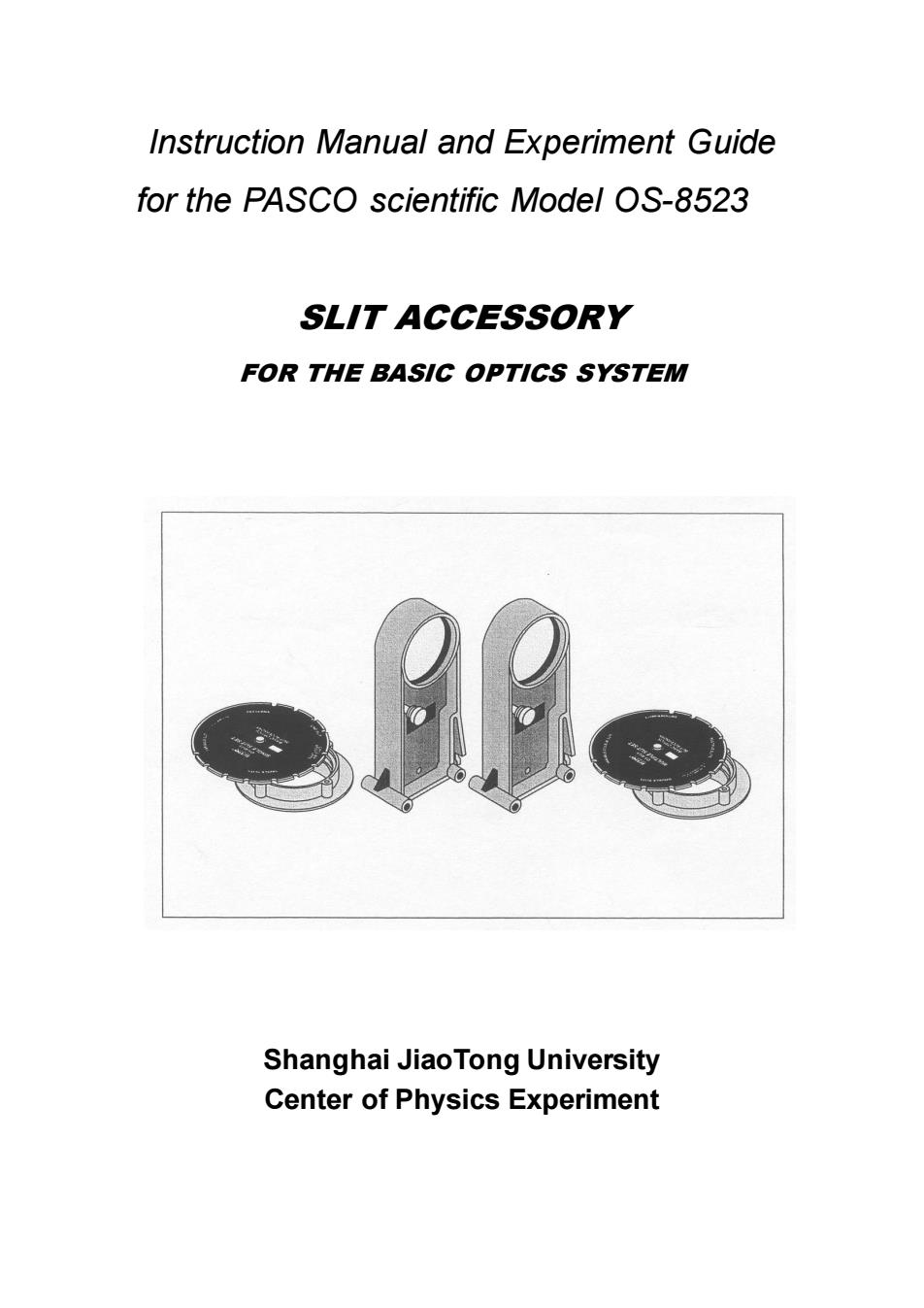
Instruction Manual and Experiment Guide for the PASCO scientific Model OS-8523 SLIT ACCESSORY FOR THE BASIC OPTICS SYSTEM Shanghai JiaoTong University Center of Physics Experiment
Instruction Manual and Experiment Guide for the PASCO scientific Model OS-8523 SLIT ACCESSORY FOR THE BASIC OPTICS SYSTEM Shanghai JiaoTong University Center of Physics Experiment
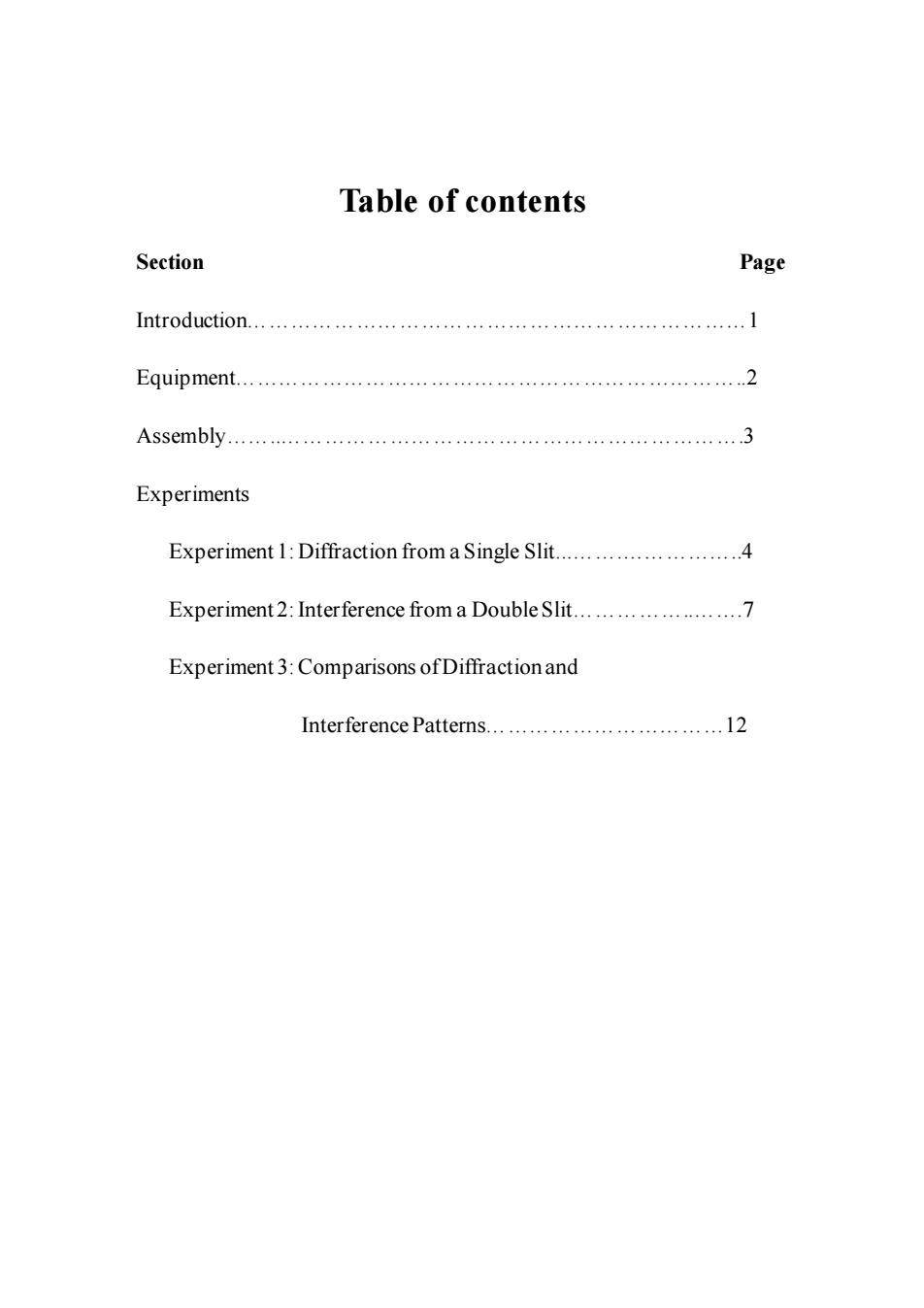
Table of contents Section Page Intr0 ductic0n..…………………………………… 1 nent......... Assembly.………… 3 Experiments Experiment 1:Diffraction from a Single Slit........................4 Experiment2:Interference from a Double Slit...................... Experiment 3:Comparisons ofDiffractionand Interference Patterns..12
Table of contents Section Page Introduction……………………………………………………………1 Equipment……………………………………………………………..2 Assembly……..……………………………………………………….3 Experiments Experiment 1: Diffraction from a Single Slit...…….……………..4 Experiment 2: Interference from a Double Slit……………..…….7 Experiment 3: Comparisons of Diffraction and Interference Patterns……………………………12
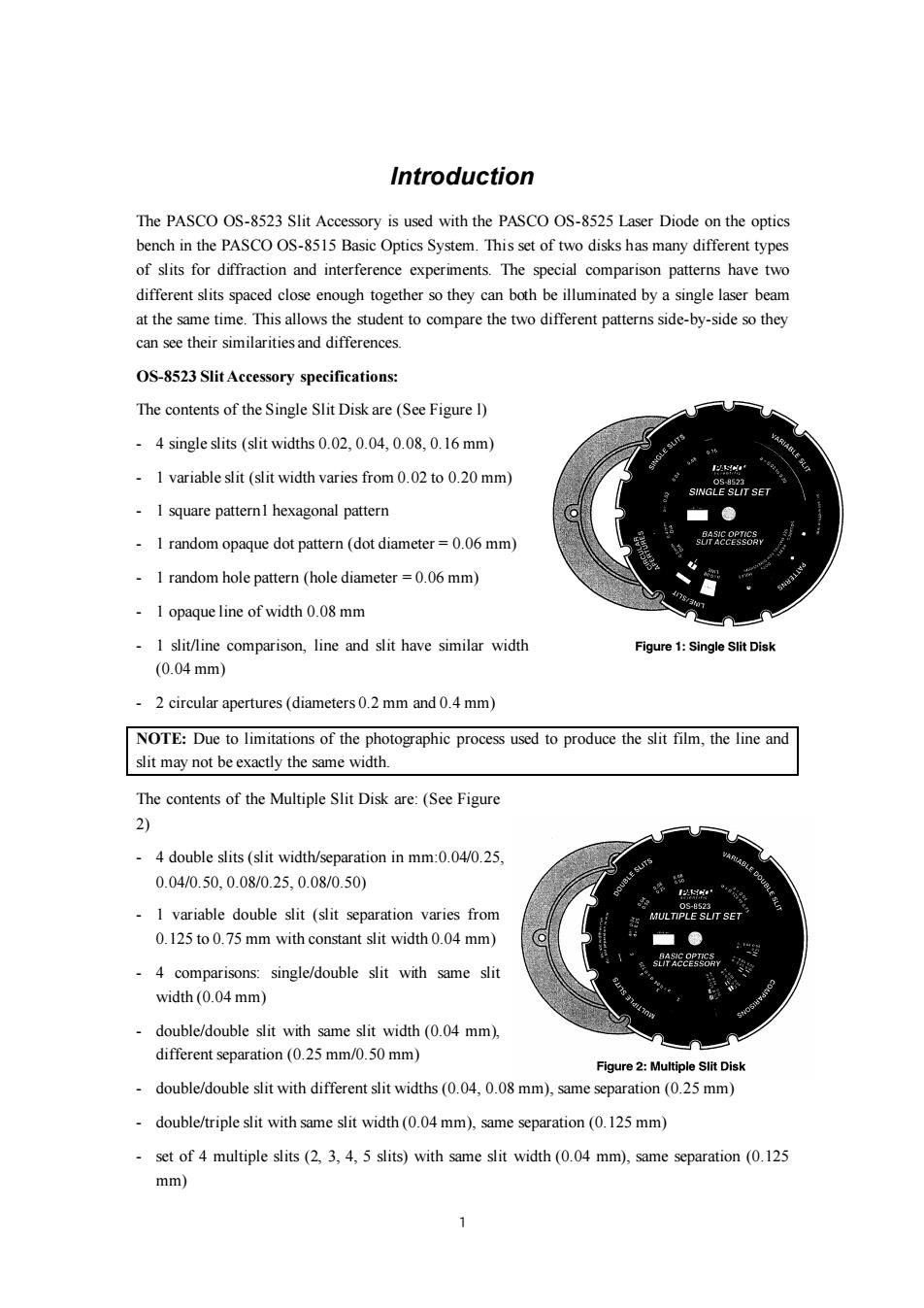
Introduction The PASCO OS-8523 Slit Accessory is used with the PASCO OS-8525 Laser Diode on the optics bench in the PASCO OS-8515 Basic Optics System.This set of two disks has many different types of slits for diffraction and interference experiments.The special comparison patterns have two different slits spaced close enough together so they can both be illuminated by a single laser beam at the same time.This allows the student to compare the two different patterns side-by-side so they can see their similarities and differences. OS-8523 Slit Accessory specifications: The contents of the Single Slit Disk are (See Figure 1) -4 single slits (slit widths 0.02,0.04,0.08,0.16 mm) -1 variable slit (slit width varies from 0.02 to 0.20 mm) SINGLE SLIT SET 1 square patternl hexagonal pattern I random opaque dot pattern (dot diameter=0.06 mm) 1 random hole pattern(hole diameter =0.06 mm) 1 opaque line of width 0.08 mm I slit/line comparison,line and slit have similar width Figure 1:Single Slit Disk (0.04mm) 2 circular apertures(diameters 0.2 mm and 0.4 mm) NOTE:Due to limitations of the photographic process used to produce the slit film,the line and slit may not be exactly the same width. The contents of the Multiple Slit Disk are:(See Figure 2) -4 double slits (slit width/separation in mm:0.04/0.25, 0.04/0.50,0.08/0.25,0.08/0.50) E 0S-8523 1 variable double slit (slit separation varies from MULTIPLE SLIT SET 0.125 to 0.75 mm with constant slit width 0.04 mm) -4 comparisons:single/double slit with same slit width (0.04 mm) double/double slit with same slit width (0.04 mm), different separation(0.25 mm/0.50 mm) Figure 2:Multiple Slit Disk double/double slit with different slit widths(0.04,0.08 mm),same separation(0.25 mm) double/triple slit with same slit width(0.04 mm),same separation (0.125 mm) set of 4 multiple slits(2,3,4,5 slits)with same slit width(0.04 mm),same separation (0.125 mm)
1 Introduction The PASCO OS-8523 Slit Accessory is used with the PASCO OS-8525 Laser Diode on the optics bench in the PASCO OS-8515 Basic Optics System. This set of two disks has many different types of slits for diffraction and interference experiments. The special comparison patterns have two different slits spaced close enough together so they can both be illuminated by a single laser beam at the same time. This allows the student to compare the two different patterns side-by-side so they can see their similarities and differences. OS-8523 Slit Accessory specifications: The contents of the Single Slit Disk are (See Figure l) - 4 single slits (slit widths 0.02, 0.04, 0.08, 0.16 mm) - 1 variable slit (slit width varies from 0.02 to 0.20 mm) - 1 square pattern1 hexagonal pattern - 1 random opaque dot pattern (dot diameter = 0.06 mm) - 1 random hole pattern (hole diameter = 0.06 mm) - 1 opaque line of width 0.08 mm - 1 slit/line comparison, line and slit have similar width (0.04 mm) - 2 circular apertures (diameters 0.2 mm and 0.4 mm) NOTE: Due to limitations of the photographic process used to produce the slit film, the line and slit may not be exactly the same width. The contents of the Multiple Slit Disk are: (See Figure 2) - 4 double slits (slit width/separation in mm:0.04/0.25, 0.04/0.50, 0.08/0.25, 0.08/0.50) - 1 variable double slit (slit separation varies from 0.125 to 0.75 mm with constant slit width 0.04 mm) - 4 comparisons: single/double slit with same slit width (0.04 mm) - double/double slit with same slit width (0.04 mm), different separation (0.25 mm/0.50 mm) - double/double slit with different slit widths (0.04, 0.08 mm), same separation (0.25 mm) - double/triple slit with same slit width (0.04 mm), same separation (0.125 mm) - set of 4 multiple slits (2, 3, 4, 5 slits) with same slit width (0.04 mm), same separation (0.125 mm)
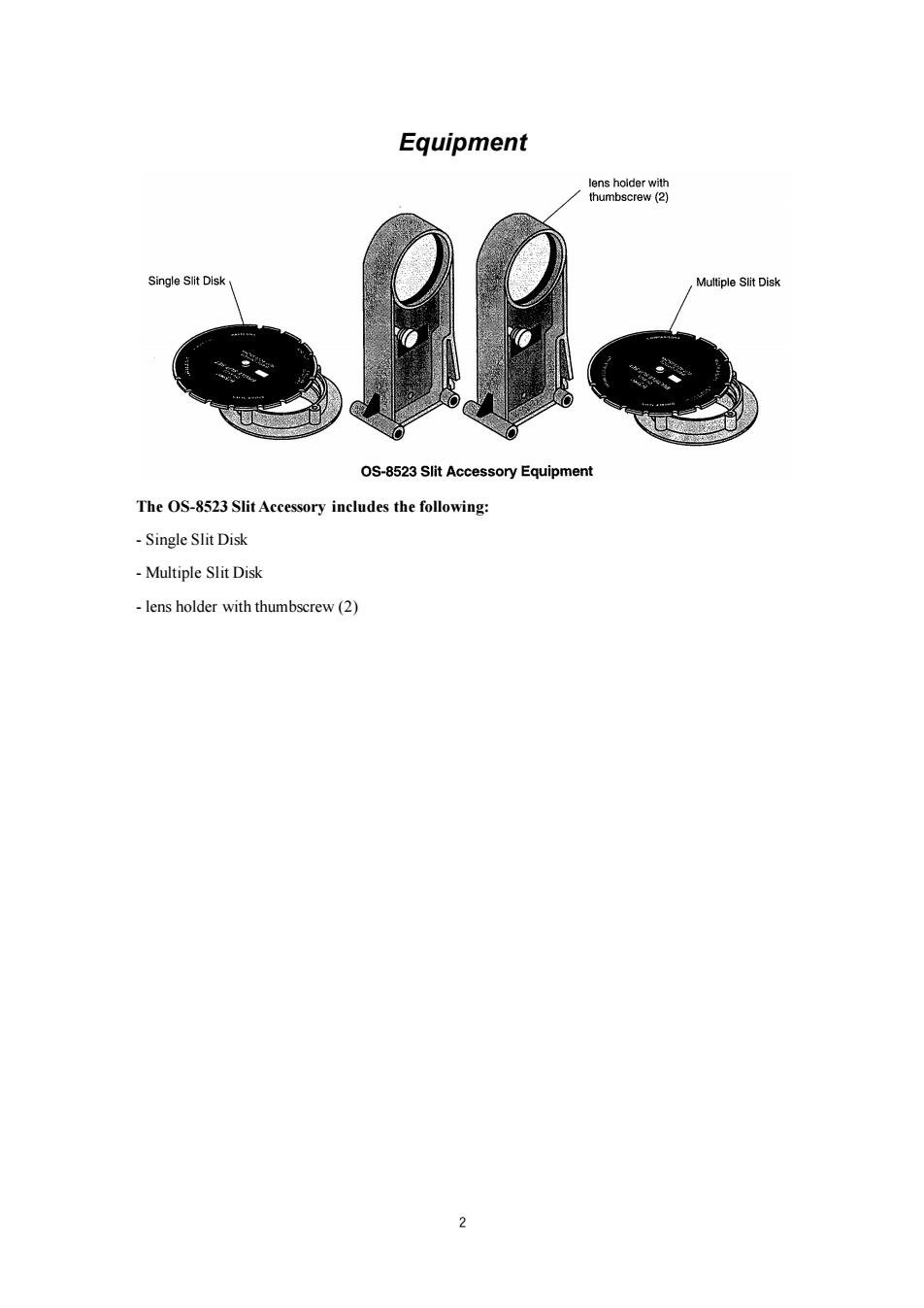
Equipment lens holder with thumbscrew (2) Single Slit Disk Multiple Slit Disk OS-8523 Slit Accessory Equipment The OS-8523 Slit Accessory includes the following: Single Slit Disk Multiple Slit Disk lens holder with thumbscrew(2) 2
2 Equipment The OS-8523 Slit Accessory includes the following: - Single Slit Disk - Multiple Slit Disk - lens holder with thumbscrew (2)
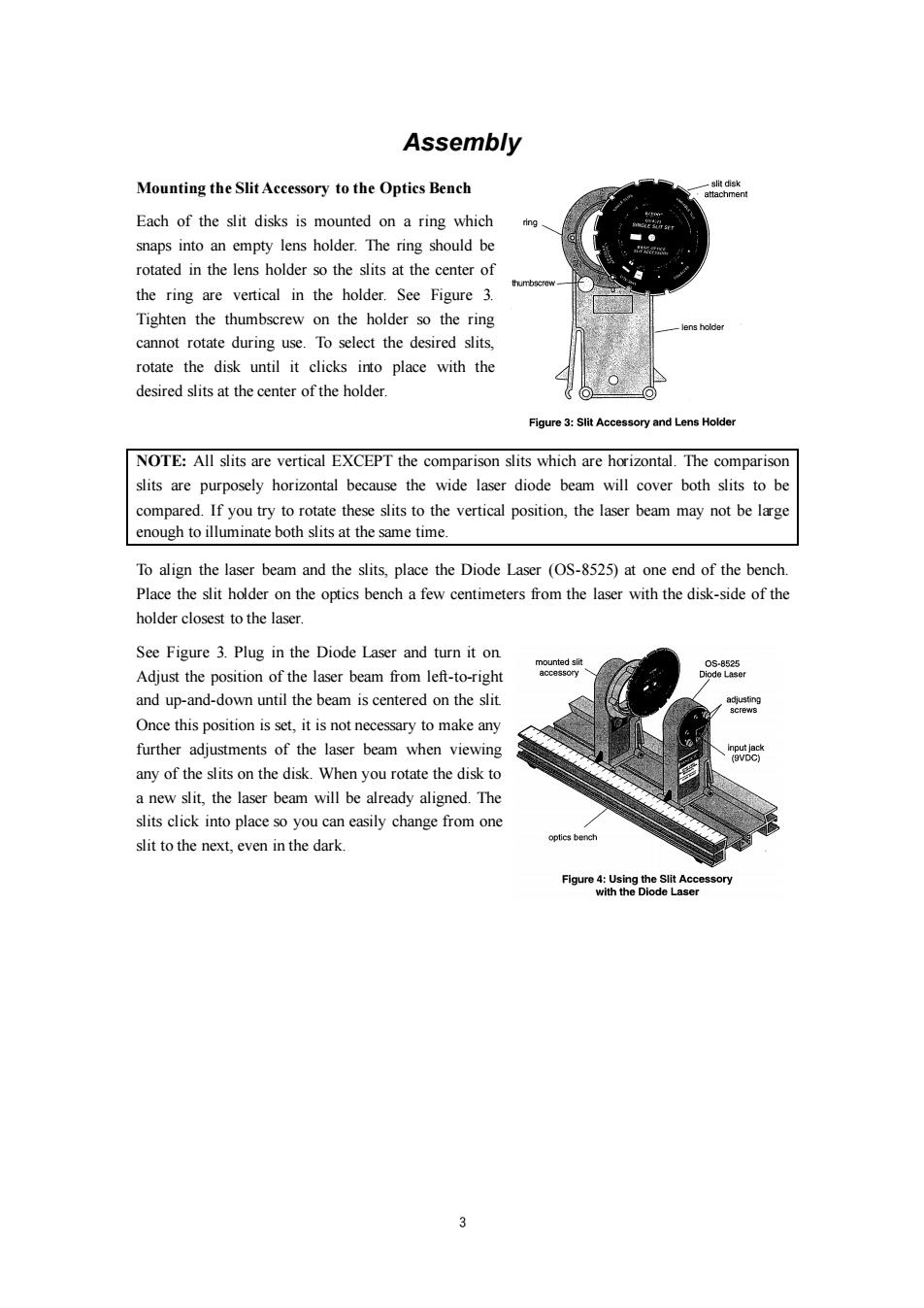
Assembly Mounting the Slit Accessory to the Optics Bench attachmen Each of the slit disks is mounted on a ring which snaps into an empty lens holder.The ring should be rotated in the lens holder so the slits at the center of thumbscrew the ring are vertical in the holder.See Figure 3. Tighten the thumbscrew on the holder so the ring lens holder cannot rotate during use.To select the desired slits, rotate the disk until it clicks into place with the desired slits at the center of the holder. Figure 3:Slit Accessory and Lens Holder NOTE:All slits are vertical EXCEPT the comparison slits which are horizontal.The comparison slits are purposely horizontal because the wide laser diode beam will cover both slits to be compared.If you try to rotate these slits to the vertical position,the laser beam may not be large enough to illuminate both slits at the same time. To align the laser beam and the slits,place the Diode Laser (OS-8525)at one end of the bench. Place the slit holder on the optics bench a few centimeters from the laser with the disk-side of the holder closest to the laser. See Figure 3.Plug in the Diode Laser and turn it on Adjust the position of the laser beam from left-to-right og and up-and-down until the beam is centered on the slit. Once this position is set,it is not necessary to make any further adjustments of the laser beam when viewing Input jack (9VDC) any of the slits on the disk.When you rotate the disk to a new slit,the laser beam will be already aligned.The slits click into place so you can easily change from one optics bench slit to the next,even in the dark. Figure 4:Using the Slit Accessory with the Diode Laser
3 Assembly Mounting the Slit Accessory to the Optics Bench Each of the slit disks is mounted on a ring which snaps into an empty lens holder. The ring should be rotated in the lens holder so the slits at the center of the ring are vertical in the holder. See Figure 3. Tighten the thumbscrew on the holder so the ring cannot rotate during use. To select the desired slits, rotate the disk until it clicks into place with the desired slits at the center of the holder. NOTE: All slits are vertical EXCEPT the comparison slits which are horizontal. The comparison slits are purposely horizontal because the wide laser diode beam will cover both slits to be compared. If you try to rotate these slits to the vertical position, the laser beam may not be large enough to illuminate both slits at the same time. To align the laser beam and the slits, place the Diode Laser (OS-8525) at one end of the bench. Place the slit holder on the optics bench a few centimeters from the laser with the disk-side of the holder closest to the laser. See Figure 3. Plug in the Diode Laser and turn it on. Adjust the position of the laser beam from left-to-right and up-and-down until the beam is centered on the slit. Once this position is set, it is not necessary to make any further adjustments of the laser beam when viewing any of the slits on the disk. When you rotate the disk to a new slit, the laser beam will be already aligned. The slits click into place so you can easily change from one slit to the next, even in the dark
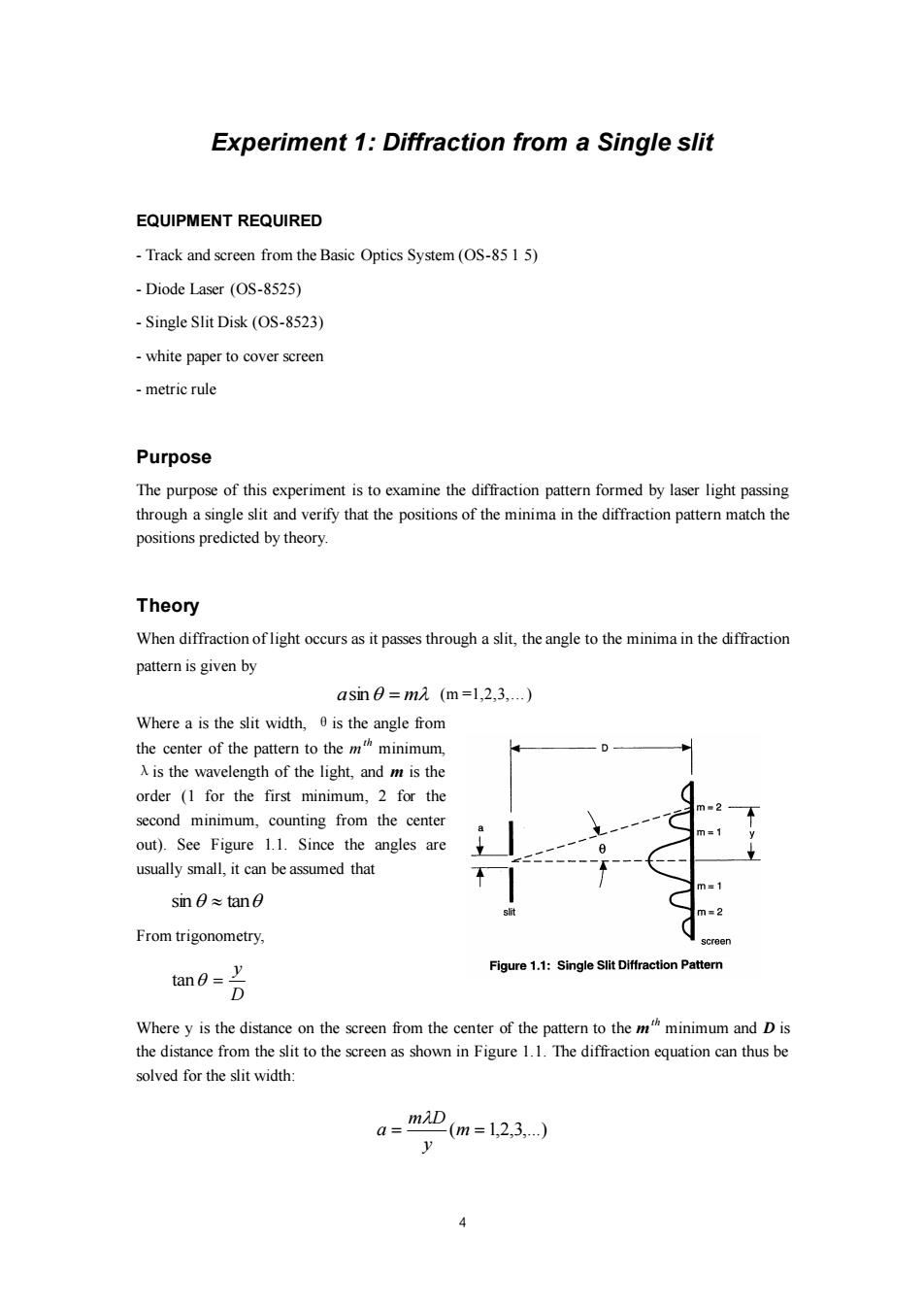
Experiment 1:Diffraction from a Single slit EQUIPMENT REQUIRED -Track and screen from the Basic Optics System(OS-85 1 5) Diode Laser (OS-8525) Single Slit Disk(OS-8523) -white paper to cover screen metric rule Purpose The purpose of this experiment is to examine the diffraction pattern formed by laser light passing through a single slit and verify that the positions of the minima in the diffraction pattern match the positions predicted by theory. Theory When diffraction of light occurs as it passes through a slit,the angle to the minima in the diffraction pattern is given by asin0=m2(m=1,2,3,..) Where a is the slit width,0 is the angle from the center of the pattern to the m minimum, A is the wavelength of the light,and m is the order (1 for the first minimum,2 for the second minimum,counting from the center out).See Figure 1.1.Since the angles are usually small,it can be assumed that sin0≈tan0 From trigonometry, creen tan0=上 Figure 1.1:Single Slit Diffraction Pattern D Where y is the distance on the screen from the center of the pattern to the m minimum and D is the distance from the slit to the screen as shown in Figure 1.1.The diffraction equation can thus be solved for the slit width: a=mi -(m=1,2,3…) y
4 Experiment 1: Diffraction from a Single slit EQUIPMENT REQUIRED - Track and screen from the Basic Optics System (OS-85 1 5) - Diode Laser (OS-8525) - Single Slit Disk (OS-8523) - white paper to cover screen - metric rule Purpose The purpose of this experiment is to examine the diffraction pattern formed by laser light passing through a single slit and verify that the positions of the minima in the diffraction pattern match the positions predicted by theory. Theory When diffraction of light occurs as it passes through a slit, the angle to the minima in the diffraction pattern is given by asin = m (m =1,2,3,…) Where a is the slit width, θis the angle from the center of the pattern to the m th minimum, λis the wavelength of the light, and m is the order (1 for the first minimum, 2 for the second minimum, counting from the center out). See Figure 1.1. Since the angles are usually small, it can be assumed that sin tan From trigonometry, D y tan = Where y is the distance on the screen from the center of the pattern to the m th minimum and D is the distance from the slit to the screen as shown in Figure 1.1. The diffraction equation can thus be solved for the slit width: = (m = 1,2,3,...) y m D a
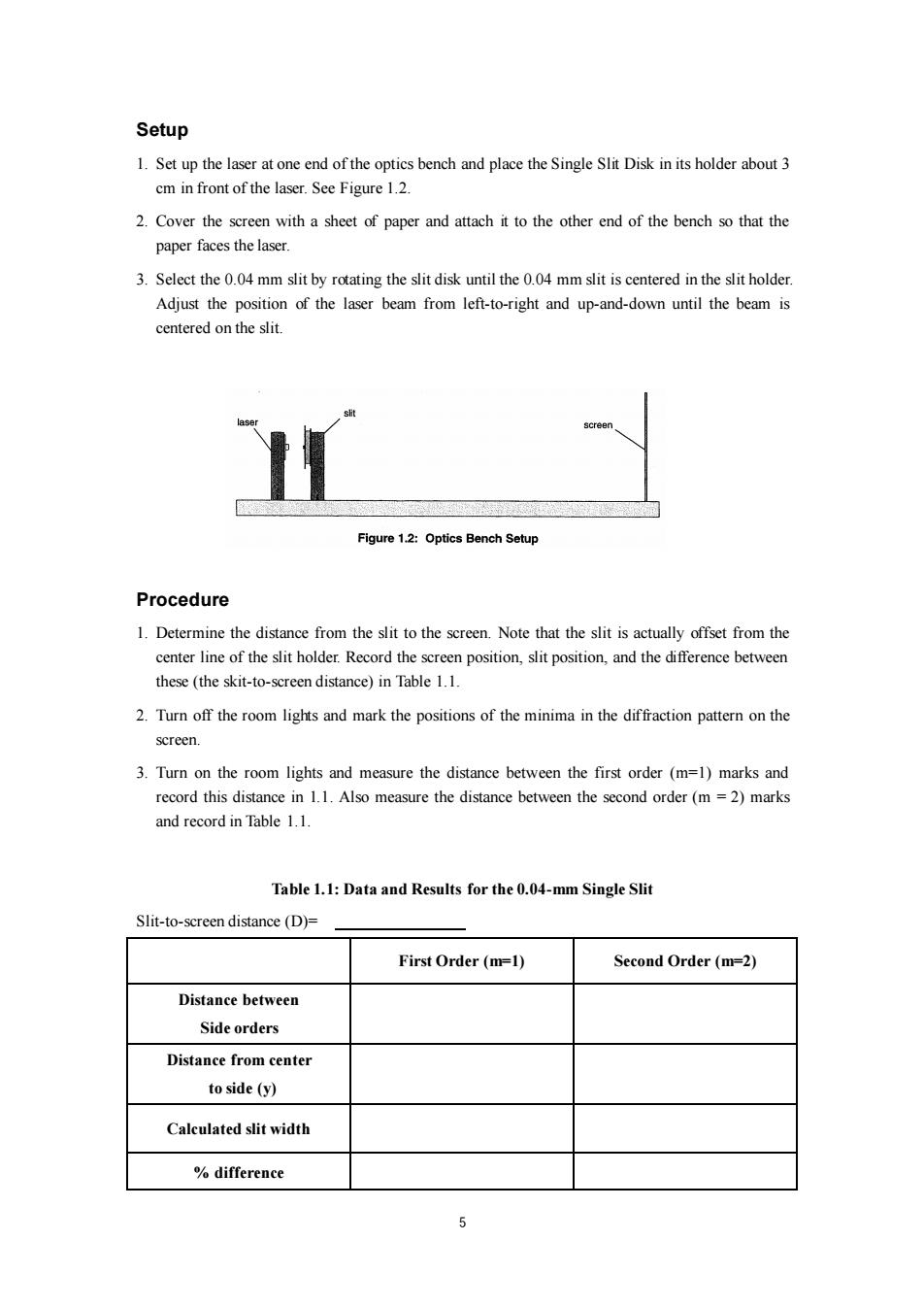
Setup 1.Set up the laser at one end of the optics bench and place the Single Slit Disk in its holder about 3 cm in front of the laser.See Figure 1.2. 2.Cover the screen with a sheet of paper and attach it to the other end of the bench so that the paper faces the laser. 3.Select the 0.04 mm slit by rotating the slit disk until the 0.04 mm slit is centered in the slit holder. Adjust the position of the laser beam from left-to-right and up-and-down until the beam is centered on the slit. screen Figure 1.2:Optics Bench Setup Procedure 1.Determine the distance from the slit to the screen.Note that the slit is actually offset from the center line of the slit holder.Record the screen position,slit position,and the difference between these (the skit-to-screen distance)in Table 1.1. 2.Turn off the room lights and mark the positions of the minima in the diffraction pattern on the screen. 3.Turn on the room lights and measure the distance between the first order (m=1)marks and record this distance in 1.1.Also measure the distance between the second order(m =2)marks and record in Table 1.1. Table 1.1:Data and Results for the 0.04-mm Single Slit Slit-to-screen distance(D)= First Order(m=1) Second Order(m=2) Distance between Side orders Distance from center to side (y) Calculated slit width difference
5 Setup 1. Set up the laser at one end of the optics bench and place the Single Slit Disk in its holder about 3 cm in front of the laser. See Figure 1.2. 2. Cover the screen with a sheet of paper and attach it to the other end of the bench so that the paper faces the laser. 3. Select the 0.04 mm slit by rotating the slit disk until the 0.04 mm slit is centered in the slit holder. Adjust the position of the laser beam from left-to-right and up-and-down until the beam is centered on the slit. Procedure 1. Determine the distance from the slit to the screen. Note that the slit is actually offset from the center line of the slit holder. Record the screen position, slit position, and the difference between these (the skit-to-screen distance) in Table 1.1. 2. Turn off the room lights and mark the positions of the minima in the diffraction pattern on the screen. 3. Turn on the room lights and measure the distance between the first order (m=1) marks and record this distance in 1.1. Also measure the distance between the second order (m = 2) marks and record in Table 1.1. Table 1.1: Data and Results for the 0.04-mm Single Slit Slit-to-screen distance (D)= First Order (m=1) Second Order (m=2) Distance between Side orders Distance from center to side (y) Calculated slit width % difference
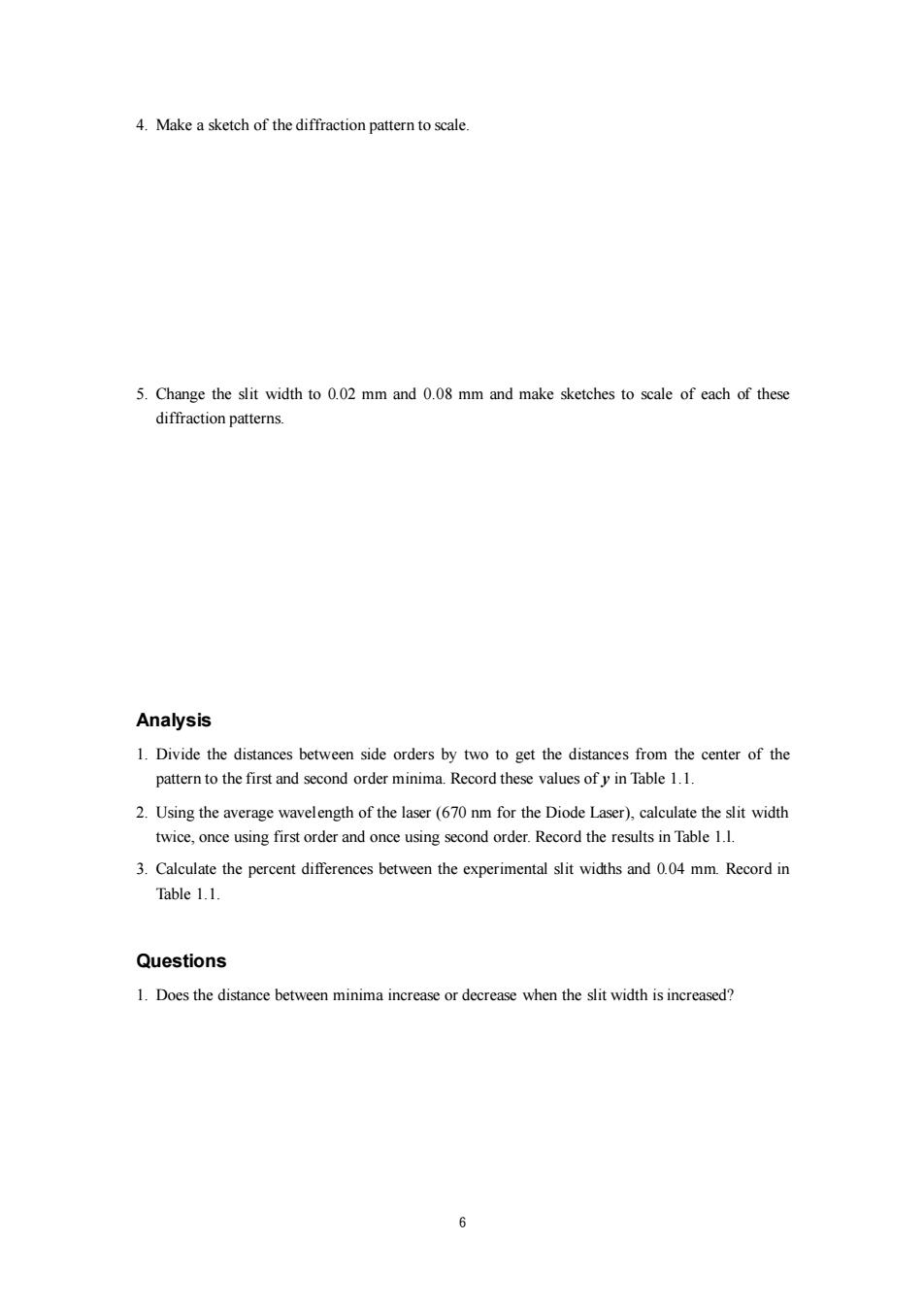
4.Make a sketch of the diffraction pattern to scale. 5.Change the slit width to 0.02 mm and 0.08 mm and make sketches to scale of each of these diffraction patterns. Analysis 1.Divide the distances between side orders by two to get the distances from the center of the pattern to the first and second order minima.Record these values ofy in Table 1.1. 2.Using the average wavelength of the laser(670 nm for the Diode Laser),calculate the slit width twice,once using first order and once using second order.Record the results in Table 1.1. 3.Calculate the percent differences between the experimental slit widths and 0.04 mm.Record in Table 1.1. Questions 1.Does the distance between minima increase or decrease when the slit width is increased? 6
6 4. Make a sketch of the diffraction pattern to scale. 5. Change the slit width to 0.02 mm and 0.08 mm and make sketches to scale of each of these diffraction patterns. Analysis 1. Divide the distances between side orders by two to get the distances from the center of the pattern to the first and second order minima. Record these values of y in Table 1.1. 2. Using the average wavelength of the laser (670 nm for the Diode Laser), calculate the slit width twice, once using first order and once using second order. Record the results in Table 1.l. 3. Calculate the percent differences between the experimental slit widths and 0.04 mm. Record in Table 1.1. Questions 1. Does the distance between minima increase or decrease when the slit width is increased?
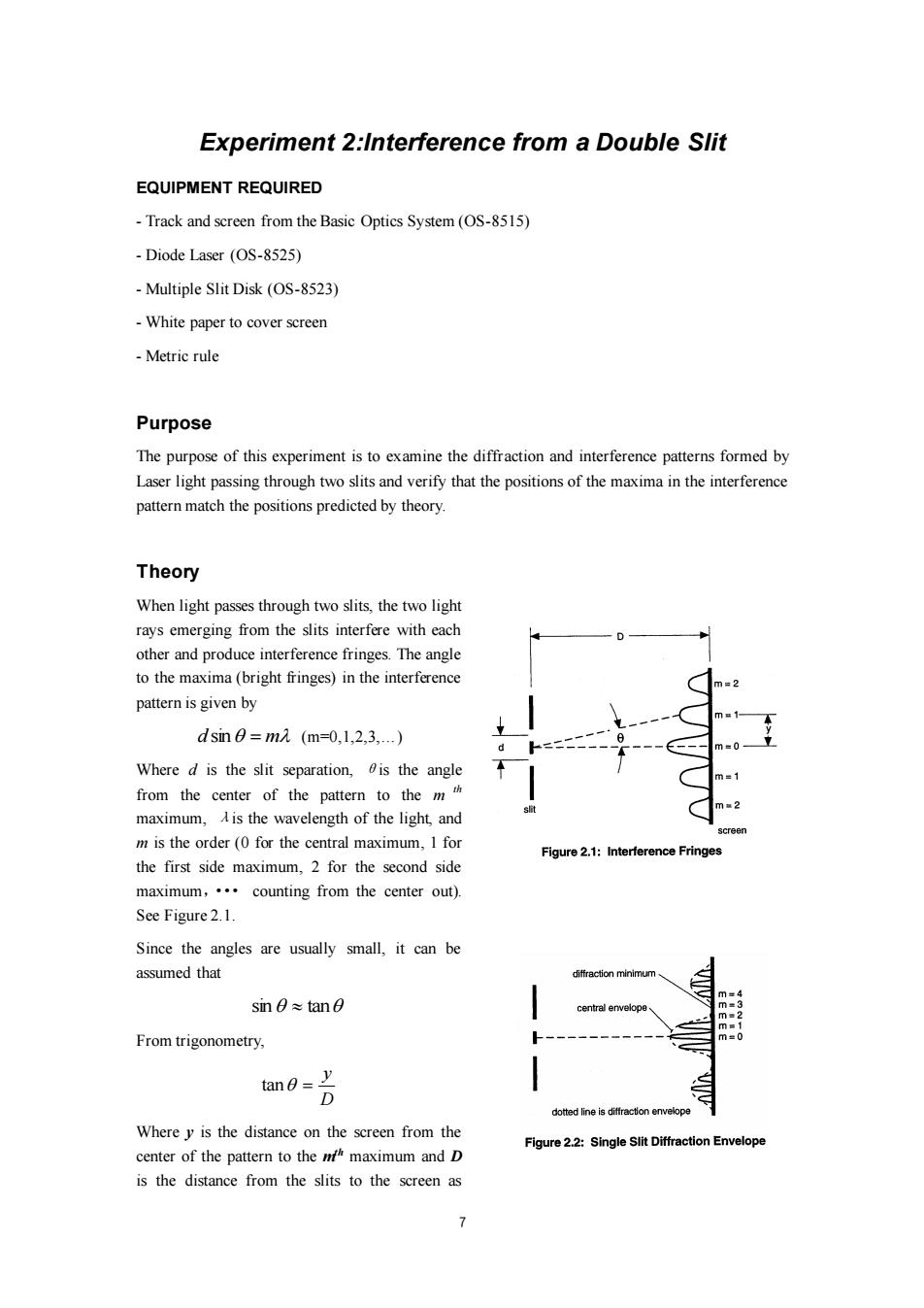
Experiment 2:Interference from a Double Slit EQUIPMENT REQUIRED -Track and screen from the Basic Optics System(OS-8515) Diode Laser (OS-8525) Multiple Slit Disk (OS-8523) -White paper to cover screen -Metric rule Purpose The purpose of this experiment is to examine the diffraction and interference patterns formed by Laser light passing through two slits and verify that the positions of the maxima in the interference pattern match the positions predicted by theory. Theory When light passes through two slits,the two light rays emerging from the slits interfere with each other and produce interference fringes.The angle to the maxima(bright fringes)in the interference pattern is given by dsin0=m2(m=0,1,2,3.) Where d is the slit separation,is the angle from the center of the pattern to the mh maximum,A is the wavelength of the light,and m is the order (0 for the central maximum,1 for Figure 2.1:Interference Fringes the first side maximum,2 for the second side maximum,··counting from the center out)). See Figure 2.1. Since the angles are usually small,it can be assumed that diffraction minimum m4 sin0≈tan0 central envelope m=3 m=2 m=1 From trigonometry, m=0 tan0s D dotted line is diffraction envelope Where y is the distance on the screen from the Figure 2.2:Single Slit Diffraction Envelope center of the pattern to the nh maximum and D is the distance from the slits to the screen as >
7 Experiment 2:Interference from a Double Slit EQUIPMENT REQUIRED - Track and screen from the Basic Optics System (OS-8515) - Diode Laser (OS-8525) - Multiple Slit Disk (OS-8523) - White paper to cover screen - Metric rule Purpose The purpose of this experiment is to examine the diffraction and interference patterns formed by Laser light passing through two slits and verify that the positions of the maxima in the interference pattern match the positions predicted by theory. Theory When light passes through two slits, the two light rays emerging from the slits interfere with each other and produce interference fringes. The angle to the maxima (bright fringes) in the interference pattern is given by d sin = m (m=0,1,2,3,…) Where d is the slit separation, θis the angle from the center of the pattern to the m th maximum, λis the wavelength of the light, and m is the order (0 for the central maximum, 1 for the first side maximum, 2 for the second side maximum,··· counting from the center out). See Figure 2.1. Since the angles are usually small, it can be assumed that sin tan From trigonometry, D y tan = Where y is the distance on the screen from the center of the pattern to the mth maximum and D is the distance from the slits to the screen as
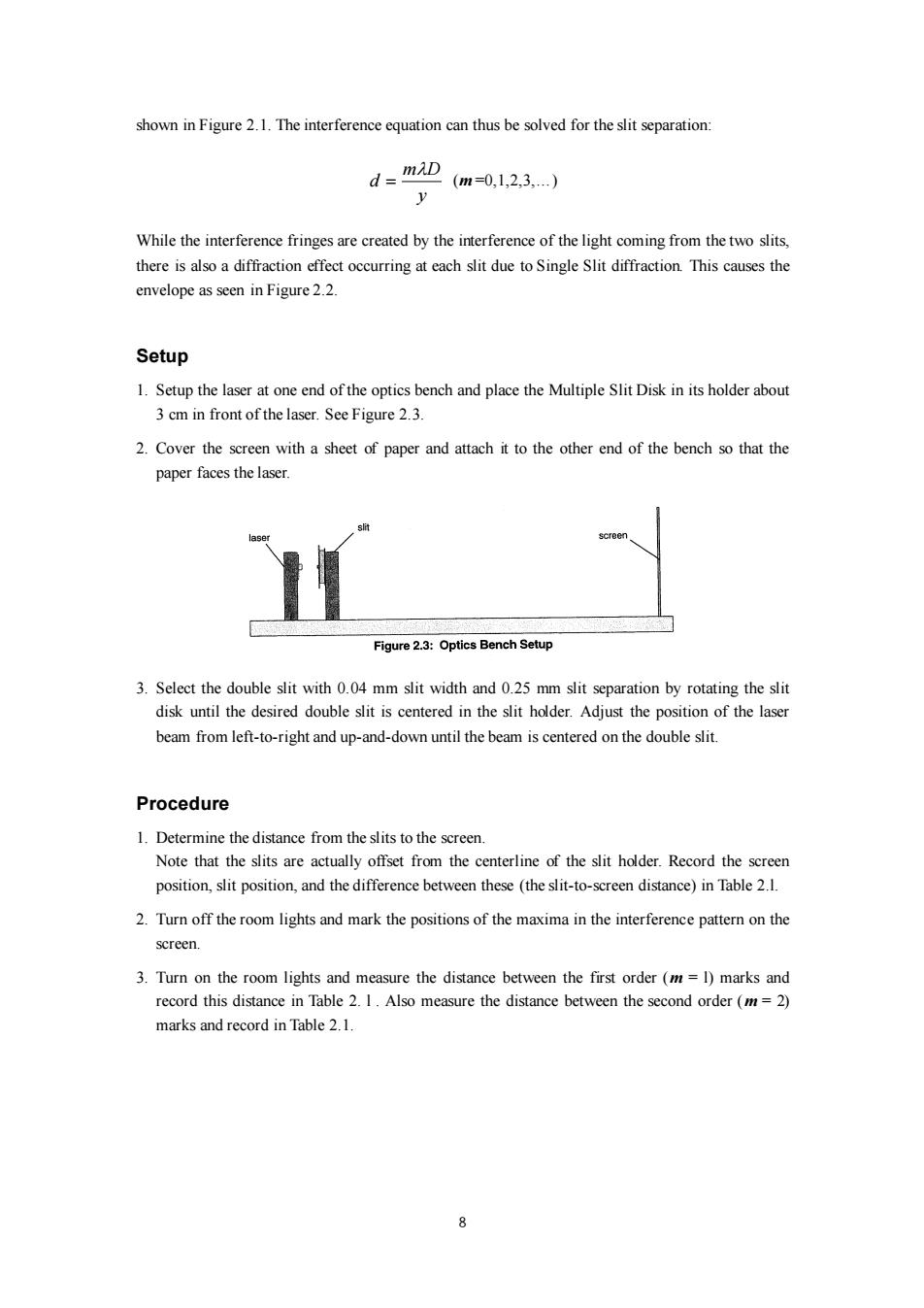
shown in Figure 2.1.The interference equation can thus be solved for the slit separation: d=miD (m=0,1,2,3,.) While the interference fringes are created by the interference of the light coming from the two slits, there is also a diffraction effect occurring at each slit due to Single Slit diffraction.This causes the envelope as seen in Figure 2.2. Setup 1.Setup the laser at one end of the optics bench and place the Multiple Slit Disk in its holder about 3 cm in front of the laser.See Figure 2.3. 2.Cover the screen with a sheet of paper and attach it to the other end of the bench so that the paper faces the laser. screen Figure 2.3:Optics Bench Setup 3.Select the double slit with 0.04 mm slit width and 0.25 mm slit separation by rotating the slit disk until the desired double slit is centered in the slit holder.Adjust the position of the laser beam from left-to-right and up-and-down until the beam is centered on the double slit. Procedure 1.Determine the distance from the slits to the screen. Note that the slits are actually offset from the centerline of the slit holder.Record the screen position,slit position,and the difference between these (the slit-to-screen distance)in Table 2.1. 2.Turn off the room lights and mark the positions of the maxima in the interference pattern on the screen. 3.Turn on the room lights and measure the distance between the first order(m=1)marks and record this distance in Table 2.I.Also measure the distance between the second order (m=2) marks and record in Table 2.1
8 shown in Figure 2.1. The interference equation can thus be solved for the slit separation: y m D d = (m =0,1,2,3,…) While the interference fringes are created by the interference of the light coming from the two slits, there is also a diffraction effect occurring at each slit due to Single Slit diffraction. This causes the envelope as seen in Figure 2.2. Setup 1. Setup the laser at one end of the optics bench and place the Multiple Slit Disk in its holder about 3 cm in front of the laser. See Figure 2.3. 2. Cover the screen with a sheet of paper and attach it to the other end of the bench so that the paper faces the laser. 3. Select the double slit with 0.04 mm slit width and 0.25 mm slit separation by rotating the slit disk until the desired double slit is centered in the slit holder. Adjust the position of the laser beam from left-to-right and up-and-down until the beam is centered on the double slit. Procedure 1. Determine the distance from the slits to the screen. Note that the slits are actually offset from the centerline of the slit holder. Record the screen position, slit position, and the difference between these (the slit-to-screen distance) in Table 2.l. 2. Turn off the room lights and mark the positions of the maxima in the interference pattern on the screen. 3. Turn on the room lights and measure the distance between the first order (m = l) marks and record this distance in Table 2. l . Also measure the distance between the second order (m = 2) marks and record in Table 2.1